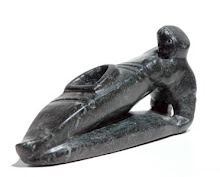
In a previous entry I ranted about my first paddle of 2008 entailing many "first times" and taking it as an omen for the year. Well, it seems I wasn't too wrong. The year keeps bringing novelties into my paddling. I now use a new Euro paddle which has made a major difference (for good) and which I definitely love. A Greenland stick (first thing I've built wit my hands ever, I think) is finished and waiting to be thoroughly tested (inevitably, there will more on both in the near future in this space). I've also visited a couple of new paddling spots, including Riaño reservoir last weekend, and that happened to be my first camping kayak trip (even if for just one night).

I took part in the third edition of the Riaño Winter Paddle. Riaño Reservoir is a largish man-made lake, reasonably high (about 1200 m asl) up among the Cantabrian Mountains in Northern Spain. Seemingly, it is also pretty much the only body of water in the country combining sufficient size and nice scenery with the potential for severe paddling conditions during winter. As such, it has been identified by some enterprising Spanish kayakers as a convenient place to test both gear and oneself and acquire experience in cold weather paddling not too far from home.

Lots of snow (Riaño I) and lots of rain at near-freezing temperatures (Riaño II) provided the sought after hardships during the two previous editions, making them a definite success. This year, however, once the morning fog cleared, we had to endure a bright, sunny day that quickly melted the night's frost and left us little choice other than enjoying the scenic landscape. Ouch. Some relief came in the form of a rather cold night at the camp (around -5º C) followed by a frosty sunrise. I suppose that trying to stuff gear into dry bags frozen rigid might qualify as a bit of a challenge.

I fear I may lack a truly adventurous spirit. I must confess that the kindly weather did not disappoint me at all and that I cherished the chance to just have a good time. Also, being, as said, my first kayak camping trip, there were some personal tests anyway that I thought covered the challenge area very adequately in my case. Choosing and managing camping gear, clothing, food and water and loading it all in my 450 cm long Creus by Fun Run Kayaks (it will soon have its well-deserved entry, too) felt enough of a trial for now.

I am happy to report it all worked very well and that my boat did live up to its builder's claim (no surprise here) of good loading capacity. Everything needed for a comfortable winter overnighter fitted neatly into the two bulkheads and with some room to spare. I had no need to carry stuff on the deck (other than the pump, paddle float and small dry bag with snacks that always go there), something I don't like at all (I might be a tad anal about it...). Hatches and dry bags did their thing: nothing got wet. Balmier conditions, requiring less and less bulky gear, sharing a tent or, if it really comes to it, some minor cluttering of the deck with cargo, should free abundant space for food and water and, thus, allow for substantially longer outings.
I eagerly look forward to them.

NOTE: The pictures above were taken by Miguel (Mijeliño) and Jaime (Borrasca) who have kindly allowed me to use them. At Jaime's blog you'll find a more extensive chronicle of the trip and links to more photographs.







